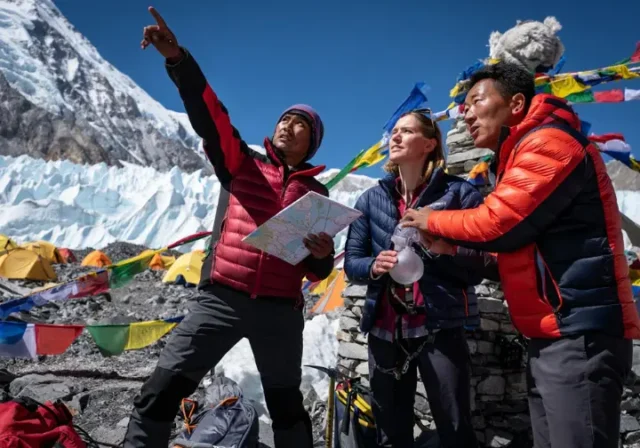In this article
Choosing when to attempt Mount Everest is far more than a matter of preference; it’s a decision with profound implications for safety and the likelihood of a successful summit. The world’s highest mountain peak is governed by powerful atmospheric forces, primarily the jet stream and the South Asian monsoon, which conspire to create very narrow windows of opportunity for climbers. This guide offers a detailed, planner-focused look at the pre-monsoon and post-monsoon climbing seasons. We will explore the risks, typical costs, expected crowds, and the growing influence of climate change on these critical periods. Journey with us as we dissect the optimal time to stand atop the summit world.
Decoding Everest’s Weather: The Science Behind Climbing Seasons

To truly grasp the best time to climb Everest, any climber must first appreciate the powerful meteorological forces at play on Mt. Everest. The formidable jet stream and the sweeping South Asian monsoon are the primary architects of Everest’s climbing calendar. Their annual dance dictates the brief, calmer periods—the coveted “summit windows”—that mountaineers depend on for their ascent. This section clarifies the science behind these phenomena, offering practical knowledge for expedition planning for this majestic mountain.
The Jet Stream: Everest’s Atmospheric Gatekeeper
The jet stream, a ribbon of fast-flowing air at high altitudes, profoundly influences conditions on Mount Everest. During winter months, it often sits directly over or very near the summit of this great mountain, bringing hurricane-force winds and extremely cold temperatures, rendering climbing attempts virtually impossible. Recognizing its typical behavior is fundamental to pinpointing viable climbing periods. For a safe ascent and safe climb, the jet stream needs to shift northwards, away from Everest’s peak. This movement typically happens in late spring, around May, leading to a reduction in wind speeds at the higher altitudes and creating the calmer conditions necessary for a summit bid. The precise timing of this northward migration is a key factor in determining the spring summit window.
As autumn transitions into winter, the jet stream begins its southward descent, eventually repositioning over the Himalayas and the broader Everest region. This shift signals the closure of the autumn climbing window, as wind speeds escalate dramatically and temperatures fall, re-establishing the severe winter environment. The strength and exact location of the jet stream can fluctuate, affecting the duration and stability of any potential weather opening. Expeditions rely on specialized meteorological forecasts to monitor these Everest’s high-altitude wind patterns and predict periods of lower wind speeds suitable for summit pushes. For those planning an expedition to this mountain peak, a thorough grasp of these patterns is essential, as is understanding extreme weather in the death zone which can be life-threatening for any climber.
The South Asian Monsoon: The Seasonal Pacemaker
The South Asian Monsoon is a vast seasonal wind system that transports moisture-rich air from the Indian Ocean towards the Himalayan range. Its arrival, generally in late May or early June, effectively concludes the spring pre-monsoon climbing season on Everest. The monsoon introduces substantial precipitation – snow at high altitudes and rain lower down – along with high humidity and reduced visibility. These weather conditions make any attempt to summit Mt Everest exceedingly dangerous for all climbers.
Throughout the monsoon months of June, July, and August, Mount Everest experiences consistently unfavorable climbing weather. The significant snowfall greatly elevates avalanche risk across the mountain. The Khumbu Icefall, part of the Khumbu glacier, can become even more unstable due to melting and ongoing precipitation. These elements make summit attempts impractical and extraordinarily hazardous. The retreat of the monsoon, typically by mid to late September, can herald the start of the post-monsoon, or autumn, climbing season. As moisture recedes and skies clear, a new, though often shorter and less predictable, opportunity may arise for climbers before winter’s grip tightens on the Himalayas. The specifics of Everest’s climbing seasons explained are deeply tied to these patterns. For a broader context, an Everest’s weather and climate overview can be very informative. Climbers should also be aware of the medical considerations for Everest climbers which are heightened during less stable periods, potentially leading to altitude sickness.
Summit Windows: Brief Opportunities for Ascent
A “summit window,” also known as a “weather window,” is a pivotal term in Everest mountaineering and peak climbing. It describes a relatively brief spell of favorable weather at high altitudes that allows for a summit attempt on Mt. Everest. These periods are defined by calmer winds, ideally below 30-40 mph, clearer skies, and manageable temperatures—conditions vital for safety and success in the oxygen-scarce “death zone.” These windows generally appear during the transitional phases between the jet stream’s dominance and the monsoon’s influence. In spring, the primary window for an ascent emerges after the jet stream has moved north but before the monsoon fully arrives, mostly in May.
In autumn, a window for a climb might form after the monsoon has withdrawn but before the jet stream descends for winter, typically in October. The length of these summit windows is quite variable. A good spring window could last from a few days to a week or slightly more, though it can be inconsistent. Autumn windows are usually shorter, less predictable, and can close abruptly, adding a layer of difficulty to post-monsoon expeditions. Precise weather forecasting and a good snow forecast are indispensable for identifying and using these fleeting opportunities. Expedition teams depend heavily on specialized meteorological services to predict the timing and duration of calm spells, enabling them to plan their summit pushes with the best data, although unexpected shifts can always occur. Understanding the conditions at Camp 4 during summit pushes is also part of this critical planning for any climber. For those interested in outcomes, Everest summit attempt statistics offer some perspective, while other sources detail the factors for a successful Everest climb.
The Pre-Monsoon (Spring) Season: The Primary Climbing Window
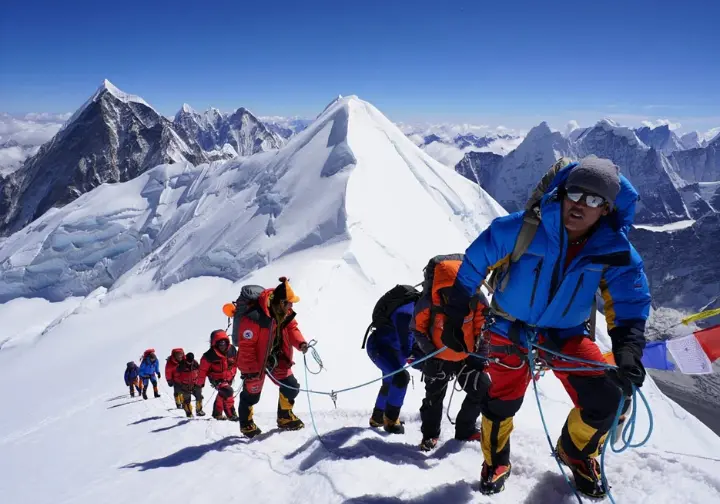
The pre-monsoon period, spanning from March to May, is widely recognized as the principal climbing window for Mount Everest, the best time to climb Everest for many. This preference is rooted in its generally more stable weather patterns and longer periods of daylight as the season progresses. We will examine the typical progression of conditions, the distinct advantages this main climbing season offers, and also address drawbacks such as significant crowding and higher operational costs. This thorough review aims to give planners a clear picture of why spring is the most popular choice for an Everest expedition.
March-April: Arrival and Acclimatization
March signals the start of the pre-monsoon climbing season, with teams arriving at Everest Base Camp (often after a trek from Lukla or a flight to the Kathmandu Valley and then a short trek) to begin the crucial, lengthy acclimatization process. Conditions on the mountain remain relatively cold, with the possibility of late winter storms, and daylight hours are shorter than in May. The primary activities during this time involve establishing the climbing route, especially through the perilous Khumbu Icefall by specialized “Icefall Doctors.” Climbers also commence their acclimatization climb rotations to higher camps, which is a cornerstone of any typical Everest expedition timeline.
April usually brings an improvement in weather, with warmer temperatures gradually rising, though nights stay very cold. This month is vital for acclimatization. Teams make multiple trips to Camp I, Camp II, and sometimes Camp III, spending nights at these increased altitudes to help their bodies adapt to lower oxygen levels and avoid high altitude sickness. The climbing rout through the Khumbu Icefall is generally well-established and maintained by this point. During these initial months, the mountain is steadily prepared for summit attempts. Sherpa teams, often excellent mountain guides, work to fix ropes on the Lhotse Face and higher, stocking camps with oxygen, food, and other essential gear for Everest expeditions, including high-altitude gear. While summit attempts are uncommon in March and April, the groundwork laid is indispensable for later success. Planners must account for this extensive preparation phase, often lasting 4-6 weeks for a climber.
May: The Prime Summit Month
May is broadly considered the optimal month for summiting Mount Everest, marking the peak time of the pre-monsoon climbing season. The jet stream has usually shifted north of the Himalayas by this time, leading to lighter winds and more stable weather at the summit. Temperatures, while still intensely colder (often -20°C to -30°C, or colder with wind chill), are generally at their “warmest” for the year at such high altitude elevations on this Himalayan peak.
These windows are eagerly awaited and heavily used, often resulting in many climbers attempting the summit of Everest concurrently. Historically, dates around May 19th to 23rd have seen high summit numbers, contributing to many historical Everest summit successes by mountaineers like Edmund Hillary. The benefits of climbing in May include the highest likelihood of favorable weather and good weather, more daylight hours compared to autumn, and well-established routes. However, May’s popularity brings notable drawbacks, chiefly overcrowding for any foreign climber. “Traffic jams” can occur on fixed lines, particularly on the final ridges, causing dangerous delays in the “death zone.” Information on typical Everest climbing conditions in May is widely available, and detailed studies describe the environmental conditions on Everest summits.
Pros and Cons of Spring Climbing
The spring climbing season presents the most statistically favorable conditions for an Everest summit. More stable and predictable weather, especially in May, often results in longer and more reliable summit windows. Warmer temperatures, though extreme, are relatively warmer than in autumn, and daylight hours are longer, aiding safety during summit pushes. Success rates for climbs are historically higher in spring. The routes are well-established, with fixed ropes frequently placed by multiple teams, and there is a significant presence of experienced Sherpas and logistical support. The Khumbu Icefall route, over the Khumbu Glacier, is actively maintained.
However, the main drawback of spring is severe overcrowding. Hundreds of climbers aiming for the summit of this mountain peak within limited weather windows can cause bottlenecks, especially on critical sections. This congestion can lead to dangerous delays, increased exposure, and a higher risk of accidents for mountaineers. The high demand also means spring expeditions are generally more expensive, with higher permit fees and logistical costs. For some expert climbers, the sheer number of people can detract from the wilderness experience. When comparing Everest climbing seasons, these factors are prominent. Additionally, comparing the cost to climb Everest in different seasons shows spring’s premium. Reliable Everest weather forecasting services are crucial for all teams making alpine ascents.
The Post-Monsoon (Autumn) Season: A Quieter, Colder Alternative
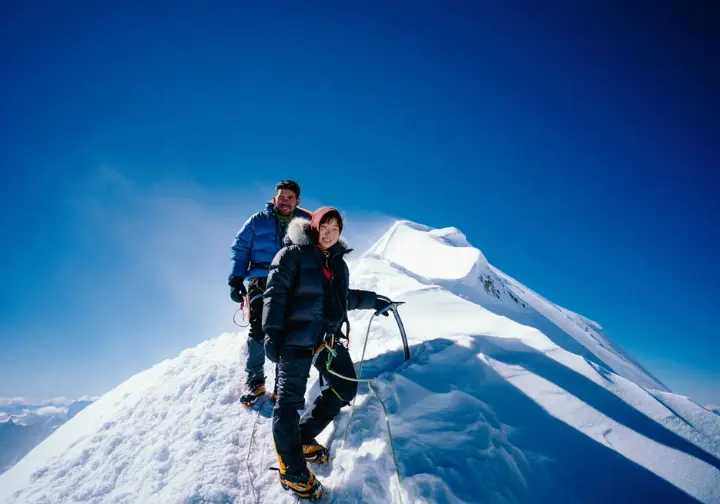
For those considering an autumn Everest climb: what planners need to know is that this climbing season, primarily September to November, offers a different Himalayan adventure. It is characterized by remarkably clear skies and significantly fewer climbers on the mountain. However, it also brings colder temperatures, often more snow accumulation from the summer monsoon, and shorter, less predictable summit windows. This section provides planners with a balanced view of this less common, yet viable, alternative for an Everest expedition for those seeking a great time with fewer crowds on the slopes.
September-October: Post-Monsoon Stability
September marks the shift from the wet summer monsoon to the drier autumn. Early September might still experience lingering monsoon moisture, but conditions generally improve as the month advances. Teams usually arrive, often via Kathmandu, and start acclimatization once the monsoon has clearly withdrawn, typically by mid-September. October is often seen as the prime month for autumn Everest attempts, a potential ideal time for some climbers. The atmosphere is usually very clear post-monsoon, offering exceptional visibility and stunning mountain views of the Himalayan range. The weather can be stable, but it is noticeably colder than in May, particularly at higher altitudes and as October progresses.
A significant challenge in autumn is the heavy snow accumulated on the upper mountain from the preceding monsoon. This can make route-breaking for the climbing rout more strenuous and potentially increase avalanche risk until the snowpack settles. The Khumbu Icefall might also need re-establishing over the glacier. Summit windows in October are generally shorter, less frequent, and less predictable than in spring. The approaching winter means decreasing daylight hours, and the jet stream begins its southward descent, bringing stronger winds and colder temperatures, especially towards the month’s end. Data on environmental conditions at South Col and Everest weather station data analysis provide scientific backing for these observations for mountaineering.
November: Approaching Winter Conditions
November signals the latter part of the autumn climbing season, with conditions rapidly becoming more winter-like on Everest. Temperatures drop substantially, often to extreme levels, and daylight hours become markedly shorter. The jet stream typically lowers its position closer to Everest, bringing a higher chance of strong winds. While summit attempts might be theoretically possible in early November if a rare weather window appears for a fall ascent, the risks increase considerably. The window for safe climbing becomes very narrow, and the margin for error shrinks due to severe cold and wind, making it a challenging time for any climber.
Most expeditions aim to be off the mountain well before mid-November. The buildup of winter snow can slow pace and make avalanche danger a more prominent concern. Logistical support may also decrease as fewer teams are on the mountain. Historically, very few successful summits have occurred in November compared to May or October on Mt. Everest. For most planners, targeting a November summit attempt carries a much lower probability of success and a significantly higher risk profile. General Nepal mountaineering information is available from the tourism board, and some operators compare Everest north versus south routes which can also be influenced by late-season conditions, including access from Tibet.
Pros and Cons of Autumn Climbing
The most notable benefit of the autumn climbing season is the drastically reduced number of climbers. This results in a quieter, less crowded experience on the mountain, at camps, and on the climbing route, which many fellow climbers find more appealing. The post-monsoon air is often exceptionally clear, offering breathtaking panoramic mountain views of the snow mountains. Permit fees for climbing Everest from the Nepal side are typically lower in autumn, which can make the overall expedition cost somewhat more manageable. Cooler temperatures, while challenging, can sometimes lead to more stable snow and ice conditions on certain sections once monsoon snow has settled on the Himalayan glacier.
The primary drawbacks are colder temperatures and shorter, less predictable weather windows. Days are shorter, and nights are significantly colder than in spring. There’s often substantial snow accumulation from the summer monsoon, making trail-breaking for an uphill climb more difficult and potentially increasing avalanche hazards. Historically, success rates for ascents in autumn are lower. There may be less extensive support infrastructure. The Khumbu Icefall can be particularly unstable as it reforms over the glacier. These aspects highlight some of the challenges of high-altitude mountaineering on these dramatic massive mountains. For context, one might look into comparing Everest route difficulties or the specific dangers of the Khumbu Icefall.
Off-Season Attempts: Understanding Extreme Risks
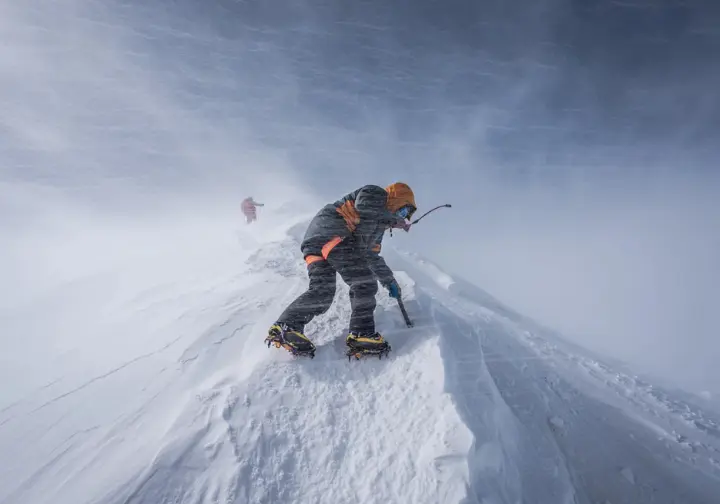
Attempting to climb Mount Everest outside the established spring and autumn climbing seasons—specifically during the deep winter months of December to February or the height of the summer monsoon from June to August—is fraught with extreme peril for any climber. These periods present conditions so prohibitive that standard expeditions do not consider them. This section aims to clearly outline the severe dangers and exceptionally low feasibility of such undertakings on Everest, strongly advising planners against them.
Winter: The Realm of Extreme Alpinism
Winter climbing on Everest, from December to February (often the coldest month), is an endeavor for only the most elite, experienced, and resilient alpinists; it is not a viable option for commercial expeditions. Conditions on the mountain are unimaginably harsh. Summit temperatures can plummet to -60°C (-76°F) or lower, with wind chills making it feel even colder. The jet stream is typically positioned directly over Everest, unleashing hurricane-force winds exceeding 100 mph. This combination creates an environment where survival itself is a monumental challenge for mountaineers.
Daylight hours are at their shortest, severely limiting climbing time and increasing risks associated with delays. Heavy snowfall is common, leading to deep, unstable snowpack and high avalanche risk on the slopes. Only a handful of successful winter ascents of Mt. Everest have ever been recorded, achieved by exceptionally skilled teams prepared for extreme hardship. The physiological and psychological toll is immense. Selecting appropriate gear for extreme cold weather conditions is just one small part of the immense challenge. Studies on global warming effects on Everest also touch upon changing extreme conditions, while news reports sometimes highlight how erratic weather and climbing windows are becoming more common.
Summer Monsoon: Unclimbable Conditions
The summer monsoon season on Everest, typically from June through August, renders the mountain largely unclimbable due to persistent, heavy precipitation. Moisture-laden winds bring continuous snowfall at higher altitudes and rain at lower elevations, creating extremely hazardous conditions for any climb. Visibility is consistently poor due to thick cloud cover and fog, making navigation difficult. The heavy, wet snowfall significantly increases avalanche risk on all slopes of these snow mountains, and the saturated snowpack can lead to widespread instability.
The Khumbu Icefall, a critical section of the South Col climbing route over the Khumbu glacier, becomes exceptionally treacherous. Increased meltwater, shifting ice, and the sheer volume of new snow make it highly unstable. Due to these severe conditions, virtually no successful summit attempts are made during the peak summer monsoon. It is universally regarded as an unsafe and impractical time to be on Everest. The climate change impact in Everest region is a growing concern affecting monsoon patterns. Information on mountaineering royalty and permit fees from official sources often specifies seasonal differences, underscoring the unsuitability of monsoon attempts.
Key Planning Factors Influenced by Season
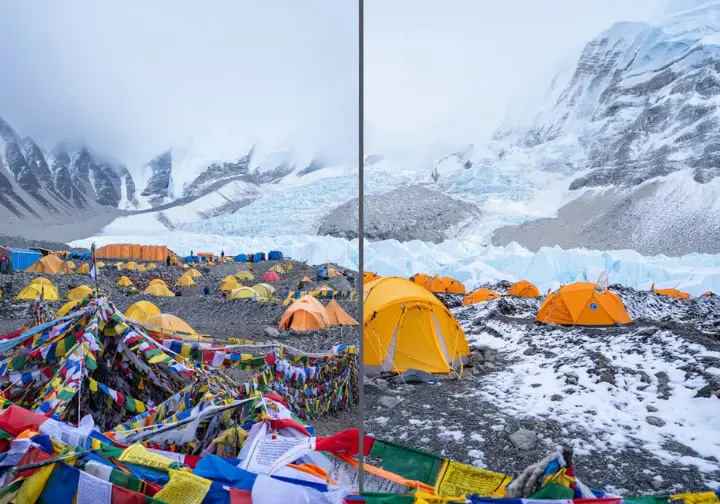
The choice between a spring or autumn expedition to Everest has significant practical consequences for planners of upcoming trips. Acclimatization strategies, overall costs, the experience of managing or avoiding crowds, the availability of support services from mountain guides, and the increasingly unpredictable nature of climate change are all deeply intertwined with seasonal timing. Understanding these interconnected factors for peak climbing is vital for developing a realistic and robust expedition plan.
Acclimatization and Expedition Duration
Proper acclimatization to high altitude is fundamental for any Everest expedition and typically dictates an overall trip duration of 6-9 weeks, irrespective of the chosen climbing season. This involves a carefully managed schedule of ascending to higher altitudes and then returning to lower camps. This process cannot be rushed without significantly increasing risks of severe altitude sickness. Seasonal weather can influence acclimatization; early spring might see colder temperatures slowing rotations, while autumn’s shorter window might add pressure for a climber to complete their acclimatization climb.
The stability and length of the anticipated summit window also play a role. Teams need to be fully acclimatized and positioned at higher camps before a good weather window opens. If a window is shorter or arrives earlier than expected, unprepared teams might miss it or ascend prematurely, risking high altitude sickness as altitude increases. Planners must build extra time into schedules for weather delays affecting acclimatization. Flexibility is paramount, as rigid schedules can clash with unpredictable mountain weather. This is a core component of the preparation and prerequisites for climbing Everest. Details on a typical Everest South Col expedition details will always highlight this phase, and up-to-date Everest climbing travel updates often mention acclimatization schedules for mountaineers.
Costs: Permits, Logistics, and Crowds
The cost of an Everest expedition is notably affected by the chosen climbing season, mainly due to demand and permit fees. Spring is the most popular and thus most expensive. Nepal’s permit fee for foreign climbers in spring is substantially higher (currently $11,000, rising to $15,000 from September 2025) than in autumn (around $5,500 before the increase). Beyond permits, higher spring demand drives up costs for logistical support, including mountain guides, Sherpa services, oxygen, and Everest base camp facilities. These climbing requirements add up.
Conversely, lower autumn demand can sometimes mean slightly lower prices for these services, though the overall cost for climbing Mt Everest remains very high. Crowd levels are a major factor. Spring’s higher costs come with significant crowding. Autumn offers fewer crowds but its own challenges that might necessitate different logistical planning, potentially offsetting some savings. Planners must budget comprehensively, considering ancillary costs like insurance, flights, personal gear (including all necessary climbing gears), tips, and contingency funds. Even seemingly small logistical details, like managing gear like phones in extreme conditions, contribute to overall preparedness for the Himalayan terrain. For broader data, Everest success and death rate statistics and historical Himalayan climbing data can offer context on seasonal outcomes for climbers.
Climate Change: The Evolving Challenge
Climate change is an increasingly critical factor for Everest planners, as it demonstrably alters the Himalayan environment and traditional climbing seasons across the entire Himalayan range. Rising global temperatures accelerate glacier melt, including the Khumbu Glacier (a major Himalayan glacier), impacting the stability of the Khumbu Icefall. Weather patterns are becoming more erratic. This includes shifts in monsoon timing and intensity, potentially leading to shorter or more volatile summit windows. Unseasonal storms or cyclones are a growing concern for mountaineering on these sky-high peaks.
Increased objective hazards such as avalanches, rockfalls from cliffs or mountain walls, and Glacial Lake Outburst Floods (GLOFs) are linked to climate change impacts. These evolving risks necessitate more dynamic risk assessment. For planners, relying solely on historical weather patterns is becoming less reliable when choosing the best time to climb Everest. Building in greater flexibility, contingency time, and staying updated with the latest climate impact research and localized forecasts are crucial for mitigating these emerging challenges for any expedition to these mountains. The Himalayan Database official site is an invaluable resource for historical data, while educational materials like the RGS Everest factsheet for teachers often touch upon environmental changes affecting glaciers and peaks.
Conclusion: Making the Definitive Choice for Your Everest Expedition
Ultimately, the pre-monsoon spring climbing season, particularly May, remains the statistically “best time to climb Everest” for many time climbers, offering more stable weather and historically higher success rates for a successful ascent. However, this peak time comes with the significant trade-offs of large crowds and higher expenses. The post-monsoon autumn season, primarily October, presents a quieter, clearer alternative for an ascent, but climbers must contend with colder temperatures, more challenging snow conditions on the steep glacier faces, and less predictable, shorter summit windows.
The “definitive” choice for your climb itinerary hinges on a planner’s individual priorities, tolerance for risk, available budget, and depth of experience with mountaineering. It requires carefully weighing factors like anticipated weather, crowd density, overall cost, and personal safety margins for a safe climb. Furthermore, the increasing impact of climate change cannot be ignored; planners must stay informed about evolving conditions and build flexibility into their long-term Everest aspirations. We hope this comprehensive understanding aids your meticulous planning for climbing efficiently, fostering skill development in high-altitude expedition strategy and promoting sustainable, respectful approaches to iconic peaks like Mount Everest, one of the most revered snow-capped mountains.
Frequently Asked Questions about the Best Time to Climb Everest
What are the absolute safest months to attempt an Everest summit? >
How much shorter is the typical summit window in autumn compared to spring? >
Why is spring so much more crowded on Everest than autumn? >
Is it significantly more dangerous to climb Everest in early March or late November? >
We are a participant in the Amazon Services LLC Associates Program, an affiliate advertising program designed to provide a means for sites to earn advertising fees by advertising and linking to Amazon.com. As an Amazon Associate I earn from qualifying purchases. We also participate in other affiliate programs. The information provided on this website is provided for entertainment purposes only. We make no representations or warranties of any kind, expressed or implied, about the completeness, accuracy, adequacy, legality, usefulness, reliability, suitability, or availability of the information, or about anything else. Any reliance you place on the information is therefore strictly at your own risk. Additional terms are found in the terms of service.



